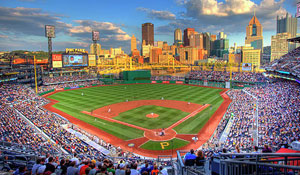PNC Park

PNC Park Profile
| LOCATION: Pittsburgh, Pennsylvania | COUNTRY: USA | YEAR OPENED: 2001 |
| CAPACITY: 38,496 | OWNER: Sports & Exhibition Authority of Pittsburgh and Allegheny County | GAME: Base Ball |
PNC Park is a baseball park located on the North Shore of Pittsburgh, Pennsylvania. It is the fifth home of the Pittsburgh Pirates, the city's Major League Baseball (MLB) franchise. It opened during the 2001 Major League Baseball season, after the controlled implosion of the Pirates' previous home, Three Rivers Stadium. The ballpark is sponsored by PNC Financial Services, which purchased the naming rights in 1998 PNC Park features a natural grass playing surface and seats 38,362 people for baseball. Funded in conjunction with Heinz Field and the David L. Lawrence Convention Center, the $216 million park stands along the Allegheny River, on the North Shore of Pittsburgh with a view of Downtown Pittsburgh. Plans to build a new stadium for the Pirates originated in 1991, but did not come to fruition for five years. Built in the style of "classic" stadiums, such as Boston's Fenway Park, PNC Park also introduced unique features, such as the use of limestone in the building's facade The park also features a riverside concourse, steel truss work, an extensive out-of-town scoreboard, and many local eateries. Constructed faster than most modern stadiums, PNC Park was built in a 24-month span. History Planning and funding On September 5, 1991, Pittsburgh mayor Sophie Masloff proposed a new 44,000-seat stadium for thePittsburgh Pirates on the city's Northside. Three Rivers Stadium, the Pirates' home at the time, had been designed for functionality rather than "architecture and aesthetics". The location of Three Rivers Stadium came to be criticized for being in a hard-to-access portion of the city, where traffic congestion occurred before and after games. Discussions about a new ballpark took place, but were never seriously considered until entrepreneur Kevin McClatchy purchased the team in February 1996. Until McClatchy's purchase, plans about the team remaining in Pittsburgh were uncertain. In 1996, Masloff's successor, Tom Murphy, created the "Forbes Field II Task Force". Made up of 29 political and business leaders, the team studied the challenges of constructing a new ballpark. Their final report, published on June 26, 1996, evaluated 13 possible locations. The "North Side site" was recommended due to its affordable cost, potential to develop the surrounding area, and opportunity to incorporate the city skyline into the stadium's design. The site selected for the ballpark is just upriver from the site of early Pirates home field Exposition Park. After a political debate, public money was used to fund PNC Park. Originally, a sales tax increase was proposed to fund three projects: PNC Park, Heinz Field, and an expansion of the David L. Lawrence Convention Center. However, after the proposal was soundly rejected in a referendum, the city developedPlan B. Similarly controversial, the alternative proposal was labeled Scam B by opponents. Some members of the Allegheny Regional Asset District felt that the Pirates' pledge of $40 million toward the new stadium was too little, while others criticized the amount of public money allocated for Plan B. One member of the Allegheny Regional Asset District board called the use of tax dollars "corporate welfare." The plan, totaling $809 million, was approved by the Allegheny Regional Asset District board on July 9, 1998â€â€with $228 million allotted for PNC Park. Shortly after Plan B was approved, the Pirates made a deal with Pittsburgh city officials to remain in the city until at least 2031. There was popular sentiment by fans for the Pirates to name the stadium after former outfielder Roberto Clemente. However, locally-based PNC Financial Servicespurchased the stadium's naming rights in August 1998. As per the agreement, PNC Bank will pay the Pirates approximately $2 million each year through 2020, and also has a full-service PNC branch at the stadium. The total cost of PNC Park was $216 million. Shortly after the naming rights deal was announced, the city of Pittsburgh renamed the Sixth Street Bridge near the southeast corner of the site of the park the Roberto Clemente Bridge as a compromise to fans who had wanted the park named after Clemente.
Circket News
Farhan, Holder seal third straight win for Islamabad
Sultans are in search of their first win in the tournament while United look increasingly impregnable
Chance for MI or SRH to get out of IPL logjam
Both batting units are coming into the game having racked up 200-plus in their previous outing
DC win an IPL classic in Delhi after Super Over drama
With nine needed off the final over with six wickets in hand, RR seemed to have the edge, only for Mitchell Starc to turn the script around
Samson says Starc won the game for Delhi Capitals
RR captain had retired hurt earlier in the innings with a side injury but he said "it feels alright"
Porel, Axar and Stubbs fire DC to 188
Sandeep Sharma went for a costly final over which included four sides and a no ball